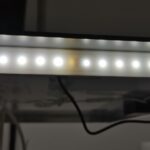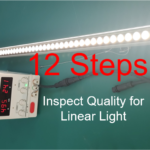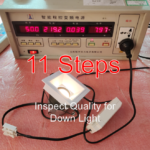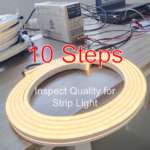With the development of LED technology and market competition, the prices of LED downlights are lower and lower.
Many manufacturers’ LED downlights look very similar from the outside.
However, as we all know, lights are long-term items that not only affect appearance but also affect real use.
All aspects of performance require attention to detail.
Today I will talk about 9 secrets that will help you get high-quality LED downlights and find reliable manufacturers.
Basics of LED Downlights
First of all, before we begin talking about the details.
It’s important to know 3 fundamental points about LED lights.
They will help you understand why you should pay attention to the points afterwards.
Two Types of LED Technologies – COB and SMD
There are 2 types of LED downlights – COB and SMD downlights, based on the type of light source.
This leads to a big difference in various important aspects between COB and SMD downlights.
For example, the structure of the lights, heat dissipation designs, housing materials etc.
You will also need to pay attention to this difference when looking for a manufacturer.
Better to work with a manufacturer that focuses on the type of LED technology that your downlight uses.
Two types of installation methods
Meanwhile, LED downlights can also be divided into surface-mounted downlights and recessed downlights, based on their installation methods.
How the downlights are installed will also require different designs, and heat dissipation, so the lights will last long.
Heat dissipation – Area and channel
We all know that there is a lot of heat generated by the LED chips.
If this heat cannot be dissipated properly then the LED downlight will not last long.
A good quality LED downlight has a good design for its heat sink.
So, it can effectively remove excess heat from inside the light fixture.
However, the heat dissipation designs are different for SMD and COB technologies.
COB LED downlights have a smaller direct heat dissipation area (contact surface for heat transfer). It is usually about the size of 1 mineral water bottle’s cap for a 30W COB downlight.
SMD LED downlights have a bigger direct heat dissipation area (contact surface for heat transfer).
It is usually about the size of 5 – 15 mineral water bottle’s caps for a 30W SMD LED downlight.
Surface-mounted downlights are fixed onto the ceiling by the back.
For this reason, the heat of the lights can not gets out as the temperature increases, affecting the temperature of the light source and drivers.
It is necessary to make additional heat dissipation channels for the lights’ housings.
Assembling methods for drivers
Most downlights have LED drivers that are separated from their housings.
In this way, the heat dissipation between them is independent.
Therefore, the lights usually will have a longer lifespan.
Meanwhile, there are also SMD LED downlights with drivers inside the housing.
The drivers are on the back of the LEDs’ plates.
For this design, the heat dissipation is not independent.
In this way, the heat will increase, and this may shorten the lifespan.
Some surface-mounted high-power COB downlights, their LED chips are assembled with the housing.
The heat will also be superimposed on each other.
The 9 tips for choosing quality LED downlights
Now you have finished reading the basics of LED downlights.
It will be helpful for you to understand why these tips will help you.
Let’s get the 9 tips on the way.
1. Pick aluminum housing for better heat dissipation
Housings are important for LED lights’ thermal performance, IP rating, and texture.
For good COB downlights, we recommend the ones with aluminum heat sinks only.
Why you should pay more attention to COB downlights’ heat sinks.
As I mentioned in Section 1, COB LED downlights have a significantly smaller direct heat dissipation area than SMD LED downlights.
However, the correct junction temperature for almost all LEDs to work properly is the same or almost the same.
Therefore, the COB downlights need heat sinks with much better heat dissipation efficiency.
Bonus tip:
Aluminum heat sinks have different types of production techniques: die-casting, cold forging, etc.
Die-cast aluminum heat sinks can have more shape designs
Cold-forged aluminum heat sinks have higher heat conductivity
Misconception:
It’s not a surprise if you may think downlights with plastic covers can’t last as long as 5 years or they are the type with lower quality.
The truth is – this is a misunderstanding.
For SMD downlights with power smaller than 8w, plastic housings, plastic-clad aluminum housings, and tin housings are all fine, if the heat dissipation area is large enough.
Even for SMD downlights with a larger wattage, it will be fine if the LEDs and drivers will work under the appropriate temperature.
2. Simulate the working environment to obtain the right temperature data
Most of the downlights work in an environment that is comfortable.
Typical examples are homes, offices, shopping malls, etc., beneficial to the service hours of lights.
However, some downlights are installed in very difficult working environments – such as the roofs of waiting halls (space up to 20 – 30 meters).
The waiting halls are air-conditioned, but the temperature of the roofs are relatively high since cold air falls and hot air rises.
Some lights are also lit during the day, and the sun heats the roof at the same time.
For this reason, the environment’s temperature for the lights will be even higher.
Bonus tips:
For this kind of installation, do an environmental simulation at the beginning of the project.
And avoid installing COB downlights.
Advice for the US and Canada
Houses in the US are built with insulation in the walls and ceilings
Undoubtedly, this design affects the heat dissipation of downlights.
Simulate the corresponding installation and remember to bury the downlights inside these filler materials.
This will give you an idea about the real temperature when the downlights begin working.
3. Safety is critical – Test to make sure the lights are safe to use
There are universal test methods for various types of LED lights’ safety.
Refer to the safety test methods in the table listed below.
Needless to say, safety is critical for users.
You must pay special attention to make sure the lights are safe to use.
Better to contact BackMorning if you need such tests.
4. Considerations for spectrum parameters – Ra, CRI, R9, CCT, SDCM
You must pay attention to the parameter SDCM.
And better to use lights from the same batch for the same project.
The color difference of lights – from different makers – may be too big even if the lights have the same color temperature.
See the picture below.
We have tested many lights with stated CRI 98 but in fact less than 95.
So you must check and make no mistakes.
For regular offices, corridors, aisles, living rooms, meeting rooms, it will be good enough to have CRI > 80 (no need for CRI > 90).
For reading rooms, fashion stores, bookstores, libraries, etc., it’d be great to have CRI > 90.
5. Considerations for optical parameters – LM/W, Beam Angle, UGR
No need to over-pursuit the glare index UGR.
Many manufacturers claim that their lights have a deep anti-glare feature.
The truth is – it is based on a significant reduction of luminous flux.
Let me give you an example to understand the point better.
Suppose you stare at a flashlight and it’s of course very harsh for your eyes – the glare is too high.
What if the flashlight is covered with a black cloth, then it is not so harsh?
However, the light is therefore much dimmer, is it not to put the cart before the horse?
The glare index of an individual downlight does not represent the anti-glare effect after installation.
Whether the light is too harsh has an important relationship with the installation method, location, and the surrounding environment.
Still the example of a very harsh flashlight – you will not feel the harshness if it is not pointing at your eyes.
Similarly, you feel very harsh at night to look at the phone in the dark.
But if you turn on the lights, or look at the phone during the day, you don’t feel harsh.
For most indoor downlights, UGR < 16 or even UGR < 19 will be fine.
6. Be clear about waterproof
Most LED downlights have a waterproof grade IP22, and some are IP44, IP65, and IP66.
Some manufacturers claim that their downlights come with waterproof grades IP44, IP65, and IP66.
It’d be better if you double-check a critical point in advance:
Is the whole light waterproof, or just the front of the light waterproof (the back and 2 sides are waterproof or not)?
BackMorning has had a few cases about the real waterproof ability of LED downlights.
The specifications of the downlights indicate IP65.
We take it for granted that IP65 for the whole light.
Therefore, we will spray water onto the front, the back, and two sides of the downlight samples.
The result?
We see liquid water inside the light after this test.
Then the manufacturer comments: Our downlights are waterproof on the front only.
This result is confusing for the buyers.
And they have to spend extra effort on clarification and confirmation.
7. Pick drivers of reputable brands
Drivers are key components for LED lights.
They determine the current and voltage for LEDs to work.
Technically, they affect the daily performance and lifespan of LED lights.
It is very important to choose LED downlights with reliable drivers.
Premium reliable downlights generally use these driver brands:
Tridonic, Philips, OSRAM, Lifud, EAGLERISE, etc.
Some LED downlight factories make drivers of their own.
This helps them lower component costs and usually with faster delivery.
Their drivers are not necessarily bad.
But remember to check whether the drivers meet quality management requirements.
It’d be better to be careful and do performance and reliability tests.
Points to check include designs, raw material management, and production processes.
8. Typical quality issues to check
BackMorning has seen some quality issues during quality inspection.
Below is a list of the typical ones.
You can take them as a checklist for reference and pay attention.
1). Overstated luminous flux:
– For example, the manufacturer claims to have 110LM/W, but the actual test is only 92LM/W
2). Too much light decay:
– for example, after 168 hours’ high temperature test, light decay is more than 5%
3). Excessive SDCM:
– For example, the required SDCM less than 5, the actual SDCM equals 8.3.
4). The light source temperature is too high:
– For example, the requirement T < 80℃, the actual T = 92.5℃
5). The heat-conducting silicone grease on the back of circuit boards is not applied evenly.
– This may cause the LEDs to burn quickly due to high temperature
6). Paint on the contact surface between housing and light source
– This will reduce the heat dissipation efficiency and shorten lifespan.
9. Choose a manufacturer with at least 3 years’ experience
LED downlights are like other lighting products – light bulbs, panel lights, and streetlights.
But they have unique components of their own, and unique production techniques.
For example, the workers must pay special attention to their fingers and not to crush the fragile gold bonding wires inside the COB chips when soldering COB light sources.
Therefore, if you want to choose a downlight manufacturer, be sure to choose a factory with more than 3 years of experience in downlight production.









